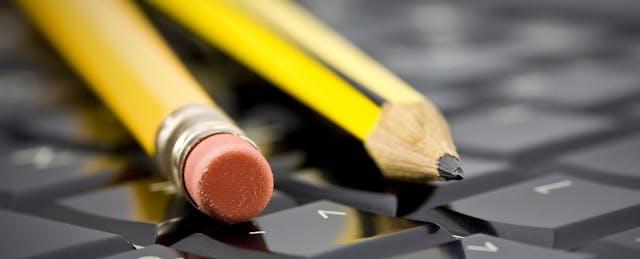Like many skills, good writing comes with good practice. Just ask Jane Hyatt Yolen, author and editor of more than 280 books, whose most notable quotes include: “Exercise the writing muscle every day, even if it is only a letter, notes, a title list, a character sketch, a journal entry. Writers are like dancers, like athletes. Without that exercise, the muscles seize up.”
But what does the research actually say about learning how to write in an increasingly digital age, let alone finding a good “workout” for our students to build the muscle? Researchers tell EdSurge that a shift towards digital over handwriting could have negative effects on young readers and writers, but some educators think technology and social media can create new ways to engage students in the writing process.
When it comes to writing and technology, some studies suggest that handwriting is better for memory—but Ron Kellogg, a professor in cognition and neuroscience at the University of St. Louis, insists that’s not the end of the story.
He explains that writing an essay or report is a complex process that combines language production, memory retrieval and thinking ability. And where he thinks the typing versus handwriting debate plays out the most interestingly is with learning the process of writing, not just memory retrieval.
“There is a concern that the more recent [generation] that isn't being taught handwriting is doing worse with the ability to learn to read, and not reading well affects the ability to write,” says Kellogg, who has studied writing and cognition since the mid 1980s. Because of that, he thinks “the de-emphasis on handwriting can be a problem.”
Neuroscientists have suggested this before. In 2014, Edouard Gentaz, a professor of developmental psychology at the University of Geneva, told the Guardian that bypassing handwriting may affect how students learn to read. “Drawing each letter by hand substantially improves subsequent recognition,” he said.
That article asserted that “although learning to write by hand does seem to play an important part in reading, no one can say whether the tool alters the quality of the text itself.” But Andrew Dillon, a professor of psychology at the University of Texas, Austin, thinks the physical act of writing can in fact play a role in students’ ability to learn how to craft longer, more meaningful texts.
“The act of handwriting does force an attention to the [writing] process,” says Dillon. The actual physical act of writing, “is an attentional attractor, which means the learning process is more concentrated for handwriting over typing. This is almost certainly important in early learning of the skill.”
Jocelyn Chadwick, a former English educator and current president of the National Council for Teachers of English, takes a more progressive stance on theories around handwriting, typing and teaching students how to craft a message. To her, what’s worked best for students both before the smartphone generation and today has been exposure to all kinds of writing, whether that be in the form of literature, newspaper journalism or billboards. Now, she says the same idea applies for digital tools like text messaging or social media platforms like Snapchat. The point is to expose them to all the different ways writing might appear or be necessary—and engage students in learning how to write at whatever level (or platform) they latch on to.
“To teach writing, such as cursive writing, that's just the mechanics of it,” says Chadwick. “If we all look at writing not as a mechanical thing, but as something that surrounds us all the time, then [writing] wouldn't be as daunting as we have made it for students and as formulaic as the five paragraph essay.”
Much of Dillon’s research focuses on digital text and cognition, and he’s interested in how writing has changed over time. It’s why he challenges the approach—at least when it involves social media or other forms with 140-character limits.
“I understand using social media is to get [students] motivated, but what we have witnessed is a tremendous shortening of the average document,” says Dillon. “The form itself is constrained. There are patterns of communication that cannot be reduced if you want to communicate ideas fully.”
Dillon claims he witnesses effects of this even at home: “I don't see handwriting disappearing, but I do see its importance changing. I see it in my own teenage son.”
Had we checked in with Chadwick ten years ago, she says her opinion would have been different on the matter, and she may not have been as open to lumping in texting and social media with her writing pedagogy. But in recent years, she’s come to appreciate digital writing tools—and thinks they can be just as effective in learning if used in a way that still offers students the same processes that writing has always involved: thinking, editing, making mistakes or even starting over.
“Some psychologies say you can't manipulate a page on a tablet [the way you can a physical paper]. But I can do that with an Apple pen on my [device],” says Chadwick. “I can draw and read and highlight notes in the margin. I can also make notes to myself on a draft, and later print it out.”
To be sure, Chadwick does not advocate for a full-fledged technology takeover when it comes to teaching students how to write. As with most lessons, she says learning happens when a teacher uses what works best for the student.
“It’s not an either-or, it’s a blend,” says Chadwick. “And the blend comes in where we reach our students.”


